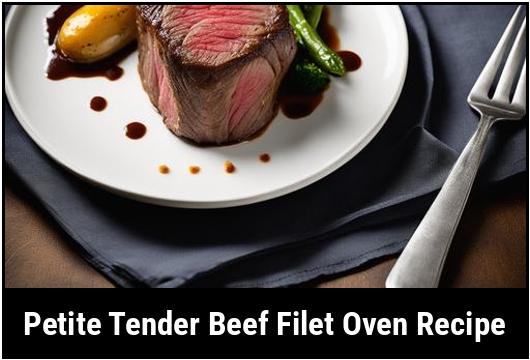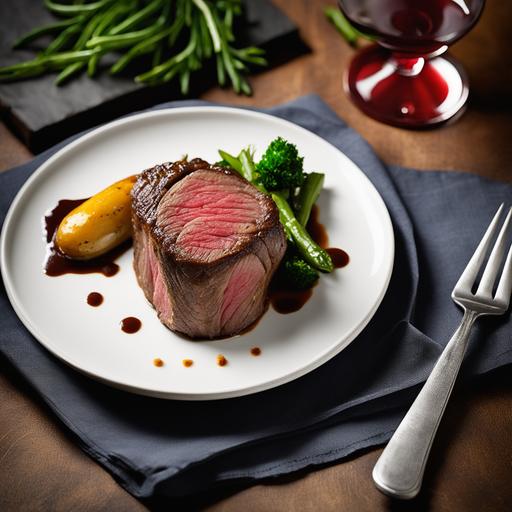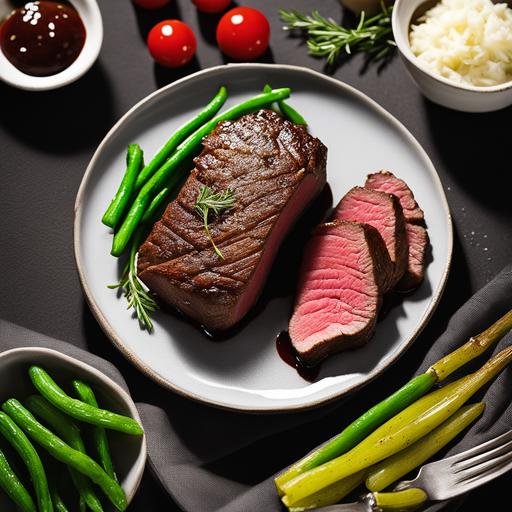
Petite Tender Beef Filet Oven Recipe : Everything You Need To Know
The petite tender beef filet, also known as the teres major, is a flavorful and tender cut of meat that is gaining popularity in the culinary world. This compact, versatile cut is perfect for various preparations, particularly when cooked in the oven. In this comprehensive article, we will delve into the food science behind the petite tender beef filet, cover culinary details and techniques, provide tips for selection, cleaning, and preparation, discuss variations of the recipe, explain how to check for doneness, and explore the consequences of overcooking or undercooking this delectable cut.
Understanding the Food Science Behind Petite Tender Beef Filet
To truly appreciate and master cooking the petite tender beef filet, it is essential to understand its food science. The petite tender is derived from the shoulder area of the beef animal, specifically from the teres major muscle. Despite its proximity to the tougher shoulder muscles, this cut remains exceptionally tender due to its relatively lower amount of connective tissue.
The tenderness of the petite tender beef filet can be attributed to its location and its fine-grained texture. Unlike some other cuts, this one does not require prolonged cooking methods like braising to break down collagen and tenderize the meat. However, due to its leanness, it is essential to be cautious not to overcook it, as it may dry out, losing its succulence.
Culinary Details and Techniques for Preparing Petite Tender Beef Filet
Selecting the Perfect Petite Tender Beef Filet
When choosing a petite tender beef filet, look for a piece with a vibrant red color and marbling evenly distributed throughout the meat. Marbling refers to the thin streaks of fat dispersed within the muscle. Optimal marbling ensures tenderness and adds flavor to the final dish.
Cleaning and Preparation
Before cooking, it is crucial to clean and prepare the petite tender beef filet properly. Start by patting the meat dry with paper towels. This step helps achieve a better sear and enhances the overall texture of the meat. Remove any excess fat or silverskin, the tough connective tissue that can inhibit tenderness.
Tips for Achieving Optimal Results
To ensure outstanding results, consider the following tips:
- Allow the petite tender beef filet to come to room temperature before cooking. This facilitates even cooking throughout the meat.
- Season the meat generously with kosher salt and freshly ground black pepper to enhance the flavor.
- Consider marinating the petite tender overnight, using a mixture of olive oil, herbs, and spices, to infuse additional flavors.
Exploring Recipe Variations
While the oven is an excellent cooking method, there are various ways to prepare petite tender beef filet. Here are a few recipe variations:
- Grilled Petite Tender Beef Filet:
- Marinate the filet in a combination of soy sauce, honey, garlic, and thyme for a few hours.
- Preheat the grill to medium-high heat.
- Grill the filet for approximately 4-6 minutes per side for a medium-rare doneness.
- Pan-Seared Petite Tender Beef Filet:
- Heat a cast-iron skillet over high heat.
- Sear the filet for approximately 3-4 minutes per side.
- Finish cooking in a preheated oven at 400°F (200°C) for an additional 6-8 minutes.
- Sous Vide Petite Tender Beef Filet:
- Vacuum-seal the seasoned filet in a food-grade bag.
- Cook in a water bath at precisely controlled temperatures. For medium-rare, set the water bath to 130°F (54°C) and cook for 1-2 hours.
- Finish by searing the meat in a hot skillet or using a kitchen torch for a flavorful crust.
Feel free to experiment with different flavors and cooking methods to find your favorite preparation style for petite tender beef filet.
Checking for Doneness and the Perils of Overcooking or Undercooking

Achieving the perfect level of doneness is paramount when cooking petite tender beef filet. Using an instant-read meat thermometer is the most reliable method to ensure precise results. Here are the internal temperature guidelines to determine desired doneness:
- Rare: 120-125°F (49-52°C)
- Medium Rare: 130-135°F (54-57°C)
- Medium: 140-145°F (60-63°C)
- Medium Well: 150-155°F (66-68°C)
- Well Done: 160°F (71°C) and above
Remember that the petite tender beef filet is best enjoyed when cooked to medium-rare or medium, allowing it to retain its tenderness and juiciness.
Overcooking petite tender beef filet can lead to dryness, resulting in a less enjoyable eating experience. Conversely, undercooking can compromise food safety and may not provide the desired texture and flavor. It is crucial to pay close attention to both the cooking time and internal temperature to achieve the perfect balance.
Petite Tender Beef Filet Oven Recipe

After exploring the food science, culinary details, and tips, here is an exemplary oven recipe for petite tender beef filet:
Ingredients:
- 1 petite tender beef filet (approximately 1 lb or 450g)
- Kosher salt and freshly ground black pepper to taste
- 2 tablespoons of olive oil
- Optional: Fresh herbs (rosemary, thyme, or oregano) for additional flavor
Instructions:
- Preheat the oven to 425°F (220°C).
- Season the petite tender beef filet generously with kosher salt and freshly ground black pepper.
- Heat an oven-safe skillet or cast-iron pan over high heat.
- Add the olive oil to the pan and carefully sear the beef filet on all sides until browned, approximately 2 minutes per side.
- If desired, add fresh herbs to the pan during the last minute of searing for extra flavor.
- Transfer the skillet to the preheated oven and roast for about 10-15 minutes or until the internal temperature reaches your desired level of doneness.
- Remove the filet from the oven and allow it to rest for 5 minutes before slicing. This resting period helps redistribute the juices, leading to a more succulent result.
- Serve the petite tender beef filet slices with your preferred side dishes or sauces.
Please note that cooking times may vary depending on the thickness of the filet and individual ovens. Always rely on the internal temperature as the most accurate indicator of doneness.
In Conclusion
The petite tender beef filet, with its tenderness and exceptional flavor, is a wonderful cut to experiment with in the kitchen. By understanding the food science, following culinary details and tips, selecting and preparing the cut properly, exploring recipe variations, and being mindful of doneness, you can create an exquisite and memorable dining experience. So, don your apron, preheat the oven, and let the petite tender beef filet take center stage in your culinary endeavors. Enjoy the journey, and savor each succulent bite!
Sources
FAQS On Petite Tender Beef Filet Oven Recipe
What Is A Petite Tender Beef Filet?
The petite tender beef filet, also known as the teres major, is a small, tender and flavorful cut of beef that comes from the chuck or shoulder area of the cow. It is an affordable alternative to pricier cuts like the tenderloin, but still provides a tender and juicy eating experience.
How Should I Prepare A Petite Tender Beef Filet In The Oven?
To cook a perfect petite tender beef filet in the oven, start by preheating your oven to 400°F (200°C). While the oven heats up, season the beef filet generously with salt and pepper or your choice of herbs and spices. Heat a cast-iron skillet over medium-high heat and add a tablespoon of oil. Once the pan is hot, sear the beef filet on all sides for about 2-3 minutes, until a golden-brown crust forms. Transfer the skillet to the preheated oven and continue cooking for about 10-12 minutes for medium-rare doneness. For well-done, cook for an additional few minutes. Remember to use a meat thermometer to check for your desired level of doneness!
How Do I Determine The Doneness Of A Petite Tender Beef Filet?
The easiest and most accurate way to determine the doneness of your petite tender beef filet is by using a meat thermometer. For a medium-rare result, aim for an internal temperature of 135-140°F (57-60°C). Keep in mind that the temperature will continue to rise slightly during resting. For a medium level, cook until the internal temperature reaches 145-150°F (63-66°C). Well-done petite tender beef filets should have an internal temperature of 160°F (71°C) or higher. Remember to insert the thermometer into the thickest part of the meat without touching the bone or the pan.
How Long Should I Let A Petite Tender Beef Filet Rest After Cooking?
It is essential to allow your petite tender beef filet to rest for about 5-10 minutes after cooking. Resting ensures that the juices redistribute throughout the meat, resulting in a more tender and flavorful bite. Tent the cooked filet loosely with aluminum foil to retain heat while resting.
What Are Some Serving Suggestions For A Petite Tender Beef Filet?
Once your petite tender beef filet is perfectly cooked, there are various ways to serve and enjoy it. You can slice it into medallions and serve it over a bed of creamy mashed potatoes or buttery roasted vegetables. Another option is to let it rest and then thinly slice it to use in sandwiches or wraps. You can also serve it alongside a refreshing salad or drizzle with a flavorful sauce such as a red wine reduction or herb butter. Let your creativity guide you when it comes to pairing this delicious cut of beef with your favorite sides and sauces!


